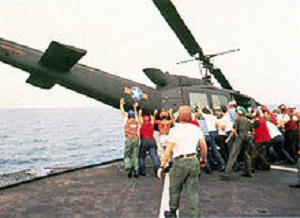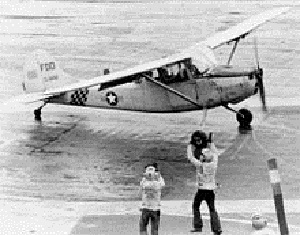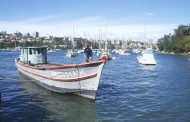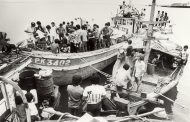10 TRIỆU ĐÔ LA MỸ
ĐỂ CỨU 7 MẠNG NGƯỜI VIỆT NAM
VÀO NHỮNG NGÀY THÁNG TƯ ĐEN NĂM 1975
Tính nhân bản của quân đội Mỹ
https://www.youtube.com/watch?v=2RdKUnO8Enw
USS Midway (CV-41)
 A South Vietnamese Air Force (VNAF) UH-1H is pushed overboard to make room for Major Buang to land his Cessna O-1.
A South Vietnamese Air Force (VNAF) UH-1H is pushed overboard to make room for Major Buang to land his Cessna O-1.
 Major Buang’s O-1 after landing aboard Midway during Operation Frequent Wind. Also, two of the deck crews are seen clapping their hands in joy.
Major Buang’s O-1 after landing aboard Midway during Operation Frequent Wind. Also, two of the deck crews are seen clapping their hands in joy.
Operation Frequent Wind
Midway, Coral Sea (CV-43), Hancock (CV-19), Enterprise (CVN-65) and Okinawa (LPH-3) responded 19 April 1975 to the waters off South Vietnam when North Vietnam overran two-thirds of South Vietnam. Ten days later, Operation Frequent Wind was carried out by U.S. 7th Fleet forces. During this operation, Midway had offloaded fifty percent of her regular combat air wing at NS Subic Bay, Philippines. She steamed to Thailand, whereupon eight CH-53 from 21st Special Operations Squadron and two HH-53 helicopters from 40th Aerospace Rescue and Recovery Squadron[6] were loaded for the purpose of ferrying people from Saigon out to the fleet cruising in the South China Sea. Hundreds of U.S. personnel and Vietnamese were evacuated to waiting ships after the fall of Saigon to the North Vietnamese.
On 29 April 1975, South Vietnamese Air Force Major Buang-Ly loaded his wife and five children into a two-seat Cessna O-1 Bird Dog and took off from Con Son Island. After evading enemy ground fire Major Buang headed out to sea and spotted the Midway. The Midway’s crew attempted to contact the aircraft on emergency frequencies but the pilot continued to circle overhead with his landing lights turned on. When a spotter reported that there were at least four people in the two-seater aircraft, all thoughts of forcing the pilot to ditch alongside were abandoned – it was unlikely the passengers of the overloaded Bird Dog could survive the ditching and safely egress before the plane sank. After three tries, Major Buang managed to drop a note from a low pass over the deck: “Can you move the helicopter to the other side, I can land on your runway, I can fly for one hour more, we have enough time to move. Please rescue me! Major Buang, wife and 5 child.” Captain Larry Chambers, the ship’s commanding officer, ordered that the arresting wires be removed and that any helicopters that could not be safely and quickly relocated should be pushed over the side. To get the job done he called for volunteers, and soon every available seaman was on deck, regardless of rank or duty, to provide the manpower to get the job done. An estimated US$10 million worth of UH-1 Huey helicopters were pushed overboard into the South China Sea. With a 500-foot ceiling, five miles visibility, light rain, and 15 knots of surface wind, Chambers ordered the ship to make 25 knots into the wind. Warnings about the dangerous downdrafts created behind a steaming carrier were transmitted blind in both Vietnamese and English. To make matters worse, five additional UH-1s landed and cluttered up the deck. Without hesitation, Chambers ordered them scuttled as well. Captain Chambers recalled in an article in the Fall 1993 issue of the national Museum of Aviation History’s “Foundation” magazine that the aircraft cleared the ramp and touched down on center line at the normal touchdown point. Had he been equipped with a tailhook he could have bagged a number 3 wire. He bounced once and came stop abeam of the island, amid a wildly cheering, arms-waving flight deck crew.
Major Buang was escorted to the bridge where Captain Chambers congratulated him on his outstanding airmanship and his bravery in risking everything on a gamble beyond the point of no return without knowing for certain a carrier would be where he needed it. The crew of the Midway was so impressed that they established a fund to help him and his family get settled in the United States.[7] The O-1 that Major Buang landed is now on display at the Naval Aviation Museum in Pensacola, FL.[8]
Upon completion of ferrying people to other ships, she returned to Thailand and disembarked the Air Force helicopters. The CH-53s then airlifted over 50 South Vietnamese Air Force aircraft to the ship. With almost 100 helicopters and aircraft of the former South Vietnamese Air Force aboard, she steamed to Guam where the aircraft and helicopters were offloaded in twenty-four hours. On her way back to the Philippines to pick up her air wing she was rerouted to act as a floating airfield in support of special operation forces rescuing a pirated cargo ship (see Mayagüez incident). She picked up her regular air wing again a month later when she returned NAS Cubi Point, Philippines.
Hoang Yen Voi
















































2 Comments
Tan Khuong
Tính nhân bản của Mỹ ở đâu khi ngưng viện trợ $700 triệu cho VNCH để QLVNCH bị bức tử; dân, quân, cán, chính Nam VN rơi vào cảnh lầm than, tụ đày; chết bỏ xác trên đường vượt biên, vượt biển tìm tự do.
human anatomy and physiology answer key
Hurrah! After all I got a blog from where I be capable of genuinely
obtain useful data regarding my study and knowledge.